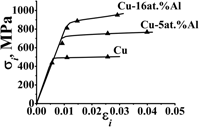Published online by Cambridge University Press: 13 December 2016

The deformation mechanisms responsible for the strength and ductility of nanostructured Cu and Cu–Al alloys processed by high pressure torsion have been analyzed in frames of a model of elastic–plastic medium and using the available experimental data. The income of the Peierls strength, as well as solid solution hardening, dislocation hardening, twinning hardening, taking into account possible annihilation processes has been estimated. It was shown that in the Cu–5 at.% Al alloy annihilation processes contribute to the maintenance of deformation. The material is hardened by the accumulation of dislocations at the twin boundaries, postponing the moment of reaching the ultimate strength. In the Cu–16 at.% Al alloy processes of the annihilation are limited. As a result, the possibility of further deformation is limited and the degree of homogeneous deformation decreases in comparison with the case of the Cu–5 at.% Al alloy. Significantly increased concentration of deformation vacancies contributes to the destruction of the former alloy as well.